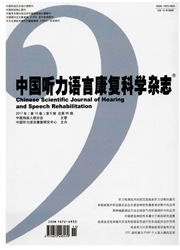

 中文摘要:
中文摘要:
目的通过在新生3天豚鼠建立高胆红素血症模型,研究其听性脑干反应(ABR)的特征,探讨高胆红素血症对听觉系统损伤的部位。方法将新生3天的豚鼠73只随机分成对照组10只、低剂量组(75μg/g)40只和高剂量组(100μg/g)23只,分别腹腔注射生理盐水或胆红素溶液,给药前和给药后1h、4h、8h分别进行ABR的动态监测,测量各波潜伏期、波间期、阈值。在给药8h后心脏取血,测其血清总胆红素(total serum bilirubin,TSB)的量。结果对照组10只豚鼠注射生理盐水后,ABR各波潜伏期、波间期及阈值未见明显变化。低剂量组(40只)豚鼠注射胆红素溶液后,14只豚鼠ABR各波潜伏期、波间期均有延长,差异有统计学意义(P〈0.05),但阈值未见明显升高。高剂量组(23只)豚鼠注射胆红素溶液后,10只豚鼠ABR各波潜伏期、波间期均延长且阈值升高,差异有统计学意义(P〈0.05)。高剂量组较低剂量组各时间点ABR各波潜伏期、波间期延长更为明显,差异有统计学意义(P〈0.05)。给药8h后高剂量组血清TSB水平高于低剂量组、高于对照组,差异有统计学意义(P〈0.05)。结论高胆红素血症可以同时损伤外周和低位脑干听觉系统,ABR各波潜伏期、波间期的变化较ABR阈值更敏感,适用于早期发现高胆红素血症引起的听觉系统损伤。
 英文摘要:
英文摘要:
Objective To investigate the characteristics of auditory brainstem responses of the neonatal P3 guinea pig hyperbilirubinemia animal model and to study the acting sites of bilirubin on the hearing system. Methods Seventy- three newborn guinea pigs at P3 were randomly divided into the control group of 10, a low dose bilirubin group of 40 and a high dose bilirubin group of 23, to which normal saline solution and 75μg/g or 100μg/g bilirubin was injected through intraperitoneal pathway respectively. The latency and inter-wave latency of ABR as well as the threshold were monitored before and lh, 4h, and 8h after administration, respectively. 8 hours later after bilirubin injection, the blood was collected from the heart and the total serum bilirubin (TSB) was measured. Results There were no obvious abnormalities in the latency, inter-wave latency and thresholds of ABR before and after injection of normal saline solution. In the low dose group, the latency and inter-wave latency of ABR were prolonged in 14 guinea pigs, but the threshold was not significantly increased. In the high dose group, the latency and inter-wave latency of ABR were prolonged and the threshold was increased in 10 guinea pigs, the degree of latency and the inter-wave latency of ABR were higher than of the lower dose group. Conclusion Hyperbilirubinemia may damage both the peripheral and low brain stem auditory systems. The changes of ABR wave latency and inter-wave period were more sensitive than the ABR threshold and total serum bilirubin, and were more suitable for the early detection of high bilirubin-induced auditory system injury.
 同期刊论文项目
同期刊论文项目
 同项目期刊论文
同项目期刊论文
 期刊信息
期刊信息
